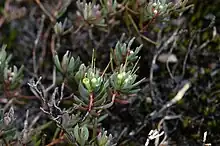Darwinia glaucophylla
Darwinia glaucophylla is a plant in the myrtle family Myrtaceae which grows as a prostrate shrub, sometimes forming extensive mats. It has bluish green leaves and white flowers in small groups which fade to reddish pink as they age. It is only known from about fifteen sites in the Gosford area and is listed as "threatened" in New South Wales legislation.
| Darwinia glaucophylla | |
|---|---|
 | |
| Scientific classification | |
| Kingdom: | Plantae |
| Clade: | Tracheophytes |
| Clade: | Angiosperms |
| Clade: | Eudicots |
| Clade: | Rosids |
| Order: | Myrtales |
| Family: | Myrtaceae |
| Genus: | Darwinia |
| Species: | D. glaucophylla |
| Binomial name | |
| Darwinia glaucophylla | |
 | |
| Occurrence data from AVH | |
Description
Darwinia glaucophylla is a prostrate shrub but with erect side branches which reach to a height of 15 cm (6 in). The leaves are arranged in opposite pairs and are bluish green with a reddish tinge, glabrous, 8–17 mm (0.3–0.7 in) long and triangular in cross section. The flowers are arranged mostly in groups of between two and four, the groups on a stalk about 1 mm (0.04 in) long. There are leaf-like bracts 8–12 mm (0.3–0.5 in) long and reddish brown bracteoles at the base of the groups but which fall off as the flowers develop. The floral cup is 7–8 mm (0.28–0.31 in) long, about 1 mm (0.04 in) wide and has distinct ribs. The sepals are 0.5 mm (0.02 in) or less long and much shorter than the petals. The style is straight, white and 12–16 mm (0.5–0.6 in) long. Flowering occurs from July to November and is followed by fruit which is a tiny capsule containing a single seed 1.5 mm (0.06 in) in diameter.[2][3][4][5]
Taxonomy and naming
Darwinia glaucophylla was first formally described in 1962 by Barbara Briggs from a specimen she collected near Kariong and the description was published in Contributions from the New South Wales National Herbarium. The specific epithet (glaucophylla) is derived from the Ancient Greek words glaukos meaning "bluish-green" or "gray"[6]: 369 and phyllon meaning "leaf".[6]: 466
Hybrids between this species and D. fascicularis are known, but are easily recognised as they have a more erect habit.[2]
Distribution and habitat
This darwinia grows in heath and open forest in soils derived from sandstone. It is only known from about fifteen sites near Calga, Kariong and Somersby.[2][3][4]
Conservation
Darwinia glaucophylla is classified as "threatened" under the New South Wales Biodiversity Conservation Act 2016. The main threats to the species are habitat degradation, inappropriate fire regimes and extension of a nearby sand mine. Some research suggests that the species may benefit from mowing and appropriate use of burning.[3][7]
References
- "Darwinia glaucophylla". World Checklist of Selected Plant Families (WCSP). Royal Botanic Gardens, Kew.
- Wilson, Peter G. "Darwinia glaucophylla". Royal Botanic Garden Sydney. Retrieved 10 May 2018.
- "Darwinia glaucophylla - profile". New South Wales Government Office of Environment and Heritage. Retrieved 10 May 2018.
- Fairley, Alan; Moore, Philip (2010). Native plants of the Sydney region : from Newcastle to Nowra and west to the Dividing Range (3rd ed.). Crows Nest, N.S.W.: Allen & Unwin. pp. 292–293. ISBN 9781741755718.
- Tindale, Mary D.; Carolin, Roger C. (1994). Flora of the Sydney region (4th ed.). Chatswood, NSW: Reed. pp. 404–405. ISBN 0730104001.
- Brown, Roland Wilbur (1956). The Composition of Scientific Words. Washington, D.C.: Smithsonian Institution Press.
- Booyens, Carmen; Chalmers, Anita; Beckers, Douglas (2014). "The effect of disturbance regime on Darwinia glaucophylla (Myrtaceae) and its habitat". Proceedings of the Linnean Society of New South Wales. 136: 231–244. Retrieved 10 May 2018.